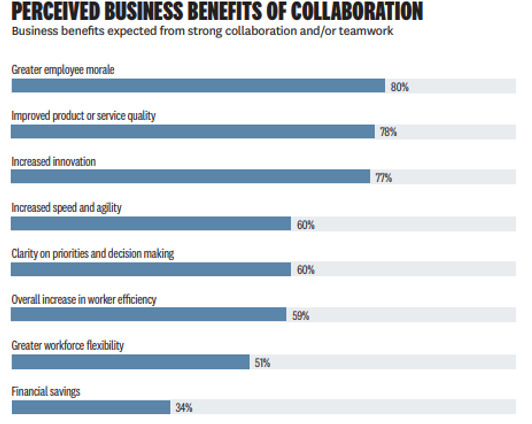Team cohesiveness arises when bonds link members of a social group to one another and the group as a whole. Before we go any further with our discussion of cohesive teams, we must first define cohesion. According to Schenk and White (2021), cohesion is a process where members who see different aspects of an issue can productively explore their differences and seek answers using their collective ideas. These can be internal teams, made up of members from different divisions.
The fundamental objective of forming cohesive teams is to bring people together to achieve a similar goal or vision. The idea behind using cohesion is that different people are more likely to come up with better explanations for various jobs at hand, the work is done faster and with better quality. The times have moved away from the days when one person would be handed a task with a possibility that at the end of the day, the end goal is not of the best quality.
With the growing use of technology in communicating with people, the idea of cohesive teams has increased and has become more attractive for many organisations. In addition, the experience of the COVID-19 pandemic has made organisations opt for the use of online communication. Scheduling meetings over sites such as Zoom and Google Teams have made it easier for this to become a reality. While this is the case, it does not take away from the fact that Cohesive teams have been around for a long time and are also famous in physical group meetings.
Venturing into the use of cohesive teams is a good idea and will probably yield abundant results. If an organisation is planning on integrating cohesive teams into its systems, there are some issues to look out for.
The Benefits of Cohesive Teams
Cohesive teams: help people to come together, solve problems, help people learn from each other, open up new means of communication, boost morale across the organisation, may lead to higher retention rates within the organisation, and may make employees work more efficiently.
Below is a graph of the survey results from a Harvard Survey conducted in 2019 regarding the perceived benefits of cohesive teams. More and more organisations are beginning to appreciate the benefits that may come along with introducing cohesive teams into the system of doing things.

(Harvard Business Review, Pulse Survey 2019)
Challenges of Team Cohesion
Advertisment
Cohesive conundrums are inevitable. When faced with this situation, it means that there are some issues regarding the new team. Remarkably, some of the pillars that strengthen a cohesive team can be the very reason why the team fails. These pillars are outlined by the Harvard Business Review (2017): large size, diversity, virtual participation, and educational levels.
Large Size
Just 10 years ago, teams rarely had more than 20 members, research shows that the size of teams has increased significantly as a result of new technologies. Large teams are frequently formed to ensure the participation of a diverse stakeholder group, the coordination of a variety of activities, and the honing of many talents. According to another research, when the size of the team grows over 20 members, the level of natural cooperation among team members decreases.
Diversity
The varied challenges that todays businesses face need people with diverse experiences and perspectives. In many cases, a sizable portion of the team would have never met. While their diverse knowledge and perspectives can stimulate insight and creativity, research suggests that the higher the number of people on the team who do not know anybody else and the greater the diversity, the less likely the team members are to share knowledge.
Virtual Participation
Because of the ever-changing global dynamics, most complex collaborative teams have members who are working at a distance from one another. Technology has allowed for team members to able to be working in ofï¬ces in the same city or spread out across the world. In a Harvard Business Review survey (2017), results showed that 40% of the teams in the sample had members all in one place. This meant that the remaining 60% was made of people in various areas. The survey also revealed that as teams become more virtual, collaboration declines.
Educational Levels
Complex cohesive teams often generate huge value by taking advantage of a variety of deeply specialised skills and knowledge to create new solutions to new or existing issues. As with the other three pillars above, the research shows that the greater the proportion of highly educated specialists on a team, the more likely the team is to disintegrate into unproductive conflicts
The Eight Ways to Build Cohesive Teams
In every team, there needs to be the right composition of the right people in the group. As we have come to understand, collaborative teams are not the normal type of teams. Not everyone can be successful working or learning with people they are not familiar with. Callahan, Schenk, and White (n.d.), point out the three most important kinds of people to have in a collaborative team. Investing in signature relationship practices – The executive or senior management team can inspire cohesive team behavior by making investments in offices such as those with open floor plans to foster communication. Many organisations have moved from a one-person office to team rooms, where employees, even from different departments can interact each day (Assbeihat, 2016).
- Modelling cohesive behaviour – One of the best ways of cementing a certain behaviour is by doing it yourself. Leading by example is a crucial aspect of wanting successful Cohesive teams. Have you ever thought of how employees will behave in the same manner that the organisations leaders exhibit?
- Creating a \"gift culture\" – When speaking about a \"gift\" culture, one needs to think about it as gifting others with things such as time and effort. Mentoring and coaching, especially on an informal basis may encourage employees to build the networks they need to work across the corporate landscape (Gratton and Erickson, 2007).
- Ensuring the requisite skills – Human Resources departments that teach employees how to develop relationships, communicate effectively, and creatively resolve conflicts may have a significant influence on team cohesiveness, according to the Harvard Business Review (2017).
- Supporting a strong sense of community – Having a sense of community in the organisation can be highly beneficial. This is because employees start to foster a feeling of belonging which results in a level of comfort. When people are comfortable with each other, it opens up room for ideas to move around and for others to ask questions. Having inquisitive individuals on the team is a win because they may bring up questions that no one has ever asked before.
- Assigning team leaders that are both tasks - and relationship-oriented – Being a leader is a big role. This should not be mistaken by the fact that someone is a manager by title. Being a leader means being the head of a team and also being part of the team at the same time. Having a leader who values relationships at the same level as valuing results, people may start to open up even more. At the end of the day, the cohesive team is bound to perform better than having a different type of leader.
- Building on heritage relationships - When too many team members are strangers, people may be reluctant to share knowledge. The best practice is to put at least a few people who know one another on the team. 40% is an excellent figure to work with as identified by a survey conducted by a Harvard Business Review survey in 2017.
- Understanding role clarity and task ambiguity - Cooperation increases when the roles of individual team members are clearly outlined yet the team is given space on how to achieve the task. Group members should be given a guideline of what is expected of them, without necessarily restricting them to how to achieve a set target of goals. Having the freedom to work in a preferred way may yield better quality result than being forced to work and behave in one specific way.
The Type of Team Players to Have in a Cohesive Team
Every team requires the proper makeup of the right people in the group. Cohesive teams, as we have seen, are not the typical type of teams. Not everyone can be successful working or learning with people they are not familiar with. Callahan, Schenk, and White (n.d.) point out the three most essential kinds of people to have in a cohesive team.
- People that are good at project management and strategy may be great supporters of team processes and hence team cohesiveness. These people like to concentrate on a single task at a time and encourage progress toward a certain objective.
- Team members that are curious and desire to expand their knowledge and identity in their fields are frequently interested in engaging in the community. People who are good people connectors can also make significant contributions to the community and network cohesiveness.
- Curious individuals, global thinkers, and those who can scan and connect people and ideas are excellent network collaborators. They are frequently the \"bridgers\" who bring ideas from the network into the community or team and test and evaluate them. They do not seem to be phased by the volume and velocity of network data.
Conclusion
While cohesive teams may appear to be a difficult project to begin, the potential benefits may outweigh the effort required to make them a success. As stated before in this article, organisations have several approaches to ensure that they have a very successful cohesive team. Having a diverse cast on the team can open up new avenues of thought and ideas that have never been explored before. Many organisations operating in this global village have found these teams to be beneficial.
Carl Tapi is a Consultant at Industrial Psychology Consultants (Pvt) Ltd, a management and human resources consulting firm. https://www.linkedin.com/in/carl-tapi-45776482/ Phone +263 (242) 481946-48/481950 or cell number +263 772 469 680 or email: carl@ipcconsultants.com or visit our website at www.ipcconsultants.com
